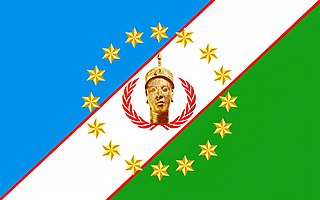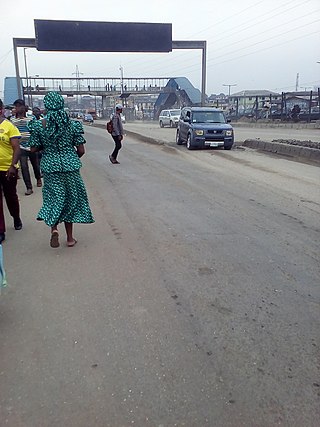Olokun is an orisha spirit in Yoruba religion. Olokun is believed to be the parent of Aje, the orisha of great wealth and of the bottom of the ocean. Olokun is revered as the ruler of all bodies of water and for the authority over other water deities. Olokun is highly praised for their ability to give great wealth, health, and prosperity to their followers. Communities in both West Africa and the African diaspora view Olokun variously as female, male, or androgynous.

Ifẹ̀ is an ancient Yoruba city in south-western Nigeria founded sometime between the years 500 BC-1000 BC. By 900AD, the city had become an important West African emporium producing sophisticated art forms. The city is located in present-day Osun State. Ifẹ̀ is about 218 kilometers northeast of Lagos with a population of over 500,000 people, which is the highest in Osun State according to population census of 2006.
Ota is a town in Ogun State, Nigeria with an estimated 163,783 residents. Ota is the capital of the Ado–Odo/Ota Local Government Area. The traditional leader of Ota is the Olota of Ota, Oba Adeyemi AbdulKabir Obalanlege. Historically, Ota is the capital of the Awori Yoruba tribe.

Ilaro is a town in Ogun State, Nigeria. Ilaro town houses about 57,850 people. Ilaro is the headquarters of the Yewa South Local government, now known as YEWALAND which replaced the Egbado division of the former Western State, and later became a part of Ogun State of Nigeria. Ilaro town is about 50 km from Abeokuta, the Ogun State capital, and about 100 km from Ikeja, the capital city of Lagos State.
Oba is a pre-nominal honorific for kings in Yorubaland, a region which is in the modern republics of Benin, Nigeria and Togo. Examples of Yoruba bearers include Oba Ogunwusi of Ile-Ife, Oba Aladelusi of Akure, and Oba Akiolu of Lagos. An example of a Bini bearer is Oba Ewuare II of Benin.

The Awori is a subgroup of the Yoruba people speaking a dialect of the Yoruba language. The Awori people are the original inhabitants of Lagos State and some parts of Ogun State, namely Ado-Odo/Ota Local Government Area of Ogun State. The Awori people are landowners, farmers and fishermen.
Akitoye, sometimes wrongly referred to as Akintoye, reigned twice as Oba of Lagos; first, from 1841 to 1845, and a second time, from 1851 to 1853. His father was Oba Ologun Kutere and his siblings were Obas Osinlokun and Adele.

The Yoruba of West Africa are responsible for a distinct artistic tradition in Africa, a tradition that remains vital and influential today.

Iga Idunganran is the Official Residence of the Oba of Lagos, situated on Lagos Island. It is also a tourist attraction.

The Yoruba people are a West African ethnic group who mainly inhabit parts of Nigeria, Benin, and Togo. The areas of these countries primarily inhabited by the Yoruba are often collectively referred to as Yorubaland. The Yoruba constitute more than 50 million people in Africa, are over a million outside the continent, and bear further representation among members of the African diaspora. The vast majority of the Yoruba population is today within the country of Nigeria, where they make up 20.7% of the country's population according to Ethnologue estimations, making them one of the largest ethnic groups in Africa. Most Yoruba people speak the Yoruba language, which is the Niger-Congo language with the largest number of native or L1 speakers.

Olowogbowo is an area in the west of Lagos Island in Lagos, also known as Apongbon. The area is in the central business district. The community was founded after 1851, when freed Yoruba captives and their descendants who had been set ashore in Sierra Leone returned in successive waves to Lagos, and were granted land to settle in the Olowogbowo and Breadfruit areas of the island.

Ikosi a major town in Kosofe Local Government Area of Lagos State.
Alayeluwa Oba Okunade Sijuwade CFR was the fiftieth traditional ruler or Ooni of Ife from 1980 to his death in 2015, taking the regnal name Olubuse II. He was a traditional ruler of Ile-Ife, Yoruba town in Osun State, Nigeria. He was crowned on 6 December 1980 in a ceremony attended by the Emir of Kano, Oba of Benin, Amayanabo of Opobo and Olu of Warri, as well as by representatives of the Queen of the United Kingdom.
Iperu or Iperu Akesan Bale Oja is a town near the Ibu River in Ogun State in the southwestern region of Nigeria. It is the most populous town in the Remo Region of the Ikenne Local Government Area. The entire LGA has an area of 137.13 km² and a population of 178,412 at the 2006 census.

Chief George Baptist Ayodola Coker was a Justice of the Nigerian Supreme Court, serving from 1964 until 1975. He was an author of two books:Family Property among the Yorubas, and a lecture series, Freedom and Justice.

His Royal Majesty, Oba Abdulwasiu Omogbolahan Lawal, Abisogun II, is the 15th Oniru of Iruland. He was born to late Chief Taoreed Lawal Akapo, the Ojora of Lagos (1977-1993) and Olori Muinat Olabisi Abeni Ajasa. He is from the Ojora, Aromire, Shokun and Abisogun branch of Oniru royal families of Lagos State. He became the 15th Oniru of Iruland on 7 June 2020 after the death of Oba Idowu Oniru in September 2019. He was presented with the staff of Office by Governor Babajide Sanwo-Olu on 7 June. 2020. Prior to his enthronement, he was the Commissioner for Agriculture in Lagos State.

Yam is a staple food in West Africa and other regions classified as a tuber crop and it is an annual or perennial crop. The New Yam festival is celebrated by almost every ethnic group in Nigeria and is observed annually at the end of June.
1851 Agidingbi ChessGame is a historical game and Nigeria's first variant of the Chess game designed by Nigerian culture activist and historian Oludamola Adebowale. It is "fashioned after the traditional chess board to teach the history of Lagos" and built to commemorate the 170th memorial anniversary of the Bombardment of Lagos by the British naval forces.

The Asa/Agere Festival in Ikorodu, Lagos State, is a vibrant cultural event celebrating the traditional stilt-walking performance unique to the region. Known locally as Agere, this festival is an integral part of Ikorodu's cultural heritage, promoting tourism and preserving traditional practices. The festival had faded from prominence but was revived in recent years to reestablish its significance.





























